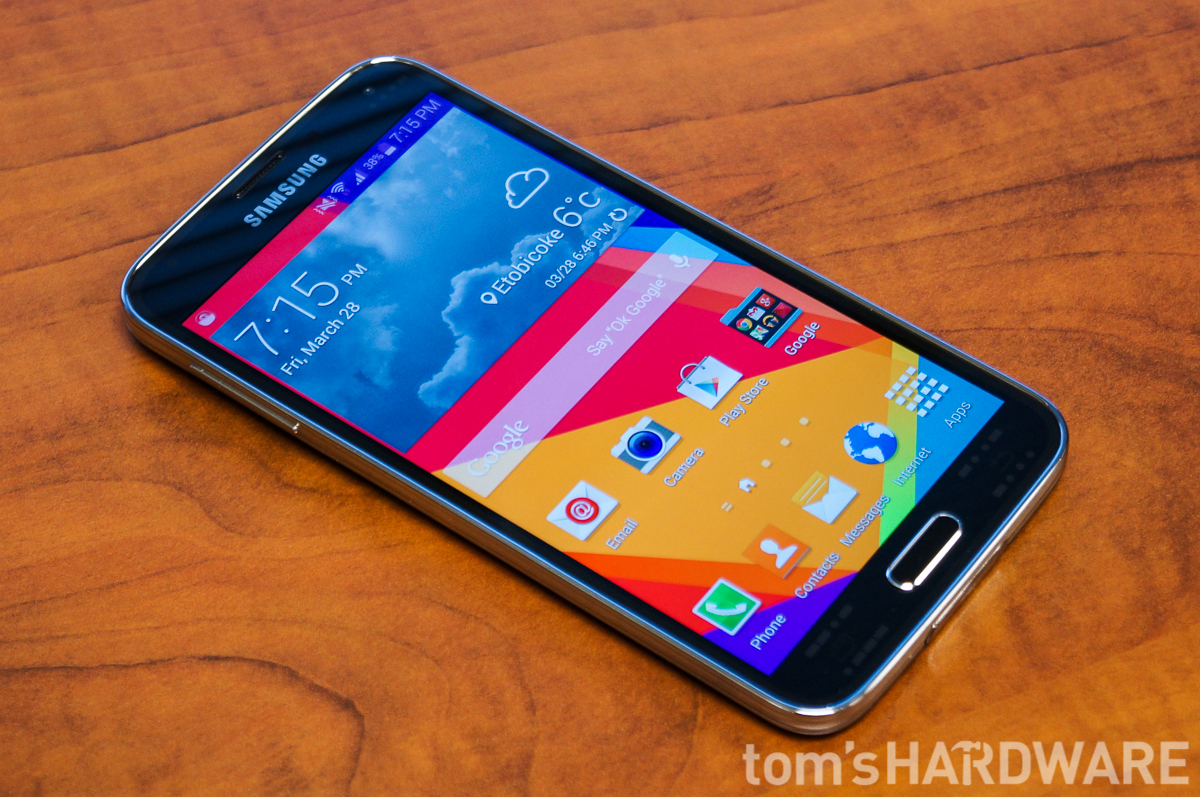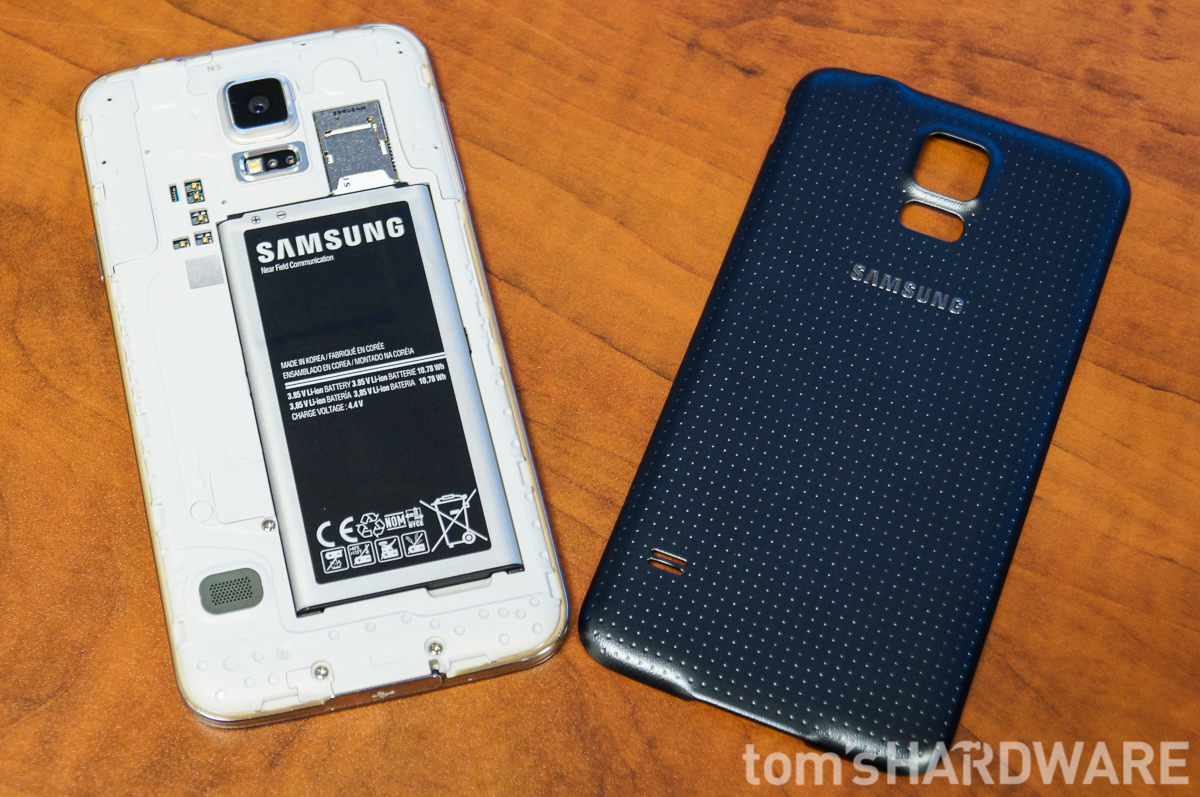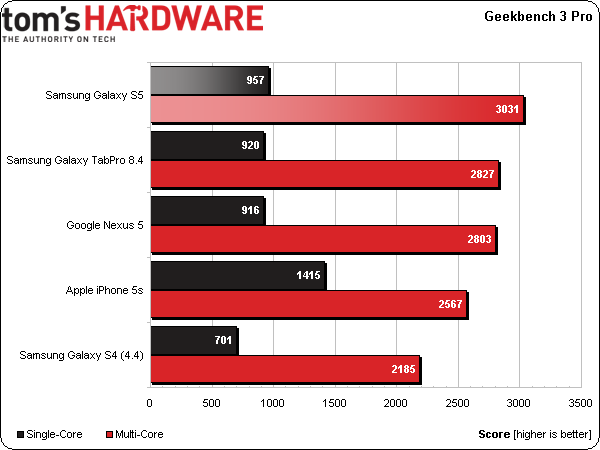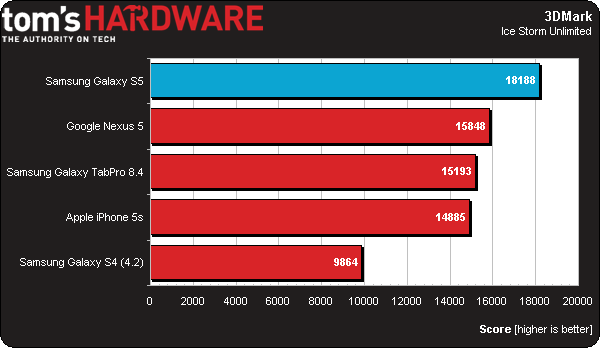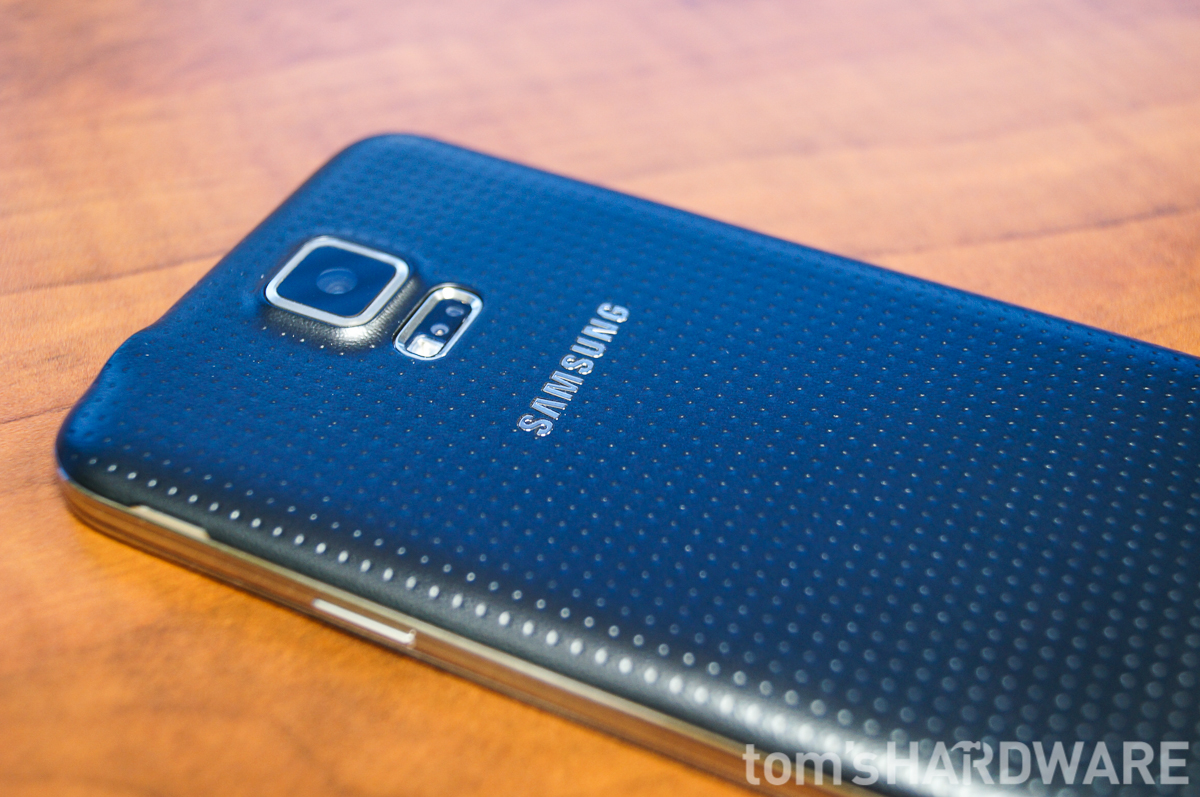Samsung Galaxy S5 Performance Preview: First Benchmarks
We have the Galaxy S5 and are putting it through its paces. Here are some early results from our testing.
Samsung seems to be getting more and more like Apple every year, and we don't mean that from the perspective of its devices copying Apple, but in that its fans seem to now expect the moon every time a phone gets upgraded, then complain incessantly online when it doesn't meet their expectations. Prior to the Galaxy S5's announcement at MWC, people had some very high expectations, including Samsung switching to a metal build for its latest flagship, and it having a 2K display. However, when it did break cover, at first it seemed to be, again, more of the same, and fans and journalists alike seemed to be disappointed. In our opinion, though, the S5 does have enough new features, both externally and under the hood, that make it more than simply a Galaxy "S4s".
Being powered by the fastest currently available SoC, the AC variant of Qualcomm's new Snapdragon 801, is to be expected of Samsung's latest flagship device, but it is some of the S5's other additions that make it stand out from the Android crowd. It now has a fingerprint scanner under the home-button, a heart-rate sensor under the camera, and is IP67 dust and water resistant. Also, the screen, while still a 1080p Super AMOLED display, has been substantially improved, at least according to DisplayMate's report, where they call it the "Best performing smartphone display that we have ever tested." Of course, we'll test that claim ourselves in our full review. On the software side of things, Samsung's new approach seems to be less is more. Instead of including everything and the kitchen sink, the S5's software is a lot more pared-down, though some say this is partially due to pressure from Google to not stray too far from their vision of Android.
Samsung Canada was kind enough to let us get our hands on the Telus version of the Galaxy S5 before its April 11 launch. While we will be posting our in-depth performance review later, we thought we'd give you a taste of this flagship device's performance now. We'll also be following this performance preview with a video of our hands-on impressions soon.
Galaxy S5 Tech Specs
While the Galaxy S5's predecessor is technically last year's Galaxy S4, its specifications are closer to the more recent Galaxy Note 3. The S5 improves substantially on the S4's Qualcomm Snapdragon 600 SoC with its much more powerful Snapdragon 801. However, when compared to the SD800 found in the Note 3, the jump in performance isn't that high.
In our recent Snapdragon 801 Performance Preview, we found that the 801 and 800 are just different revisions of the same silicon. However, the S5 DOES use the fastest variant of the 80X family, the MSM8974AC chip, that has the highest clock speed, 2.5 GHz, and fastest GPU speed, 578 MHz.
The Galaxy S5, like the S4, still only has 2 GB of RAM, but it is faster, running at 1866 MHz. Its 5.1" screen is still a Super AMOLED 1080p like the S4 and Note 3, but as noted above, tests have shown that it is a lot brighter and color accurate. The 2,800 mAh removable battery should provide stellar battery life in combination with the power efficient Snapdragon 801 SoC. The 800 powered LG G2, which has a slightly larger 3,000 mAh battery and 5.2" screen, can play continuous video for over 10 hours, so we expect similar performance, if not better, from the S5.
The Galaxy S5 also has quite an impressive number of connectivity options. It supports 802.011ac with 2x2 MIMO antenna technology for much better and faster Wi-Fi connectivity, and also supports more LTE bands for better international roaming capability.
Get Tom's Hardware's best news and in-depth reviews, straight to your inbox.
| Samsung Galaxy S5 Technical Specifications | |
|---|---|
| SoC | Qualcomm Snapdragon 801 |
| CPU Core | Krait 400 (4-core) @ 2.46 GHz |
| GPU Core | Adreno 330 @ 578 MHz |
| Memory | 2 GB RAM LPDDR3 1866 MHz RAM |
| Display | 5.1" Super AMOLED @ 1920 x 1080 (432 ppi) |
| Storage | 16 GB (tested) / 32 GB |
| Battery | 2,800 mAh (removable) |
| Camera/s | Front: 2 MP Rear: 16 MP w/4K video recording |
| Expansion Ports | microSD slot, USB 3.0 |
| Connectivity | Wi-Fi: 802.11b/g/n/ac 2x2 MIMO Cellular: LTE: Bands 1/2/3/4/5/7/17; HSPA+/UMTS: 850/1900/2100MHz; GSM: 850/900/1800/1900MHzOther: Bluetooth 4.0, NFC |
| Dimensions | 5.59" x 2.85" x 0.315" (142 mm x 72.5 mm x 8.1 mm) |
| Weight | 5.11 oz (145 g) |
| Operating System | Android 4.4.2 Kitkat w/Touchwiz UI |
| Price | $650 |
Performance Preview
We decided to compare the GS5 to a couple of its Android brethren and the top iOS device, the iPhone 5S. For the Android devices we chose the S5's immediate predecessor, the Snapdragon 600 powered Galaxy S4, the Snapdragon 800 MSM8974AA powered Nexus 5 (winner of our Elite award), and the Snapdragon 800 MSM8974AB powered Galaxy TabPro 8.4 tablet. While we would have preferred to include the Galaxy Note 3, which is also powered by MSM8974AB, the results we currently have on file are from a unit running Android 4.3, and Note 3's running that version are known to 'cheat' in certain benchmark tests, making the results unusable. Also, our Galaxy S4 results currently come from a number of different versions of Android 4.2, 4.3, and 4.4. Unfortunately, results generated with 4.3 are flawed, since the S4 'cheats' on benchmarks when running that version of Android. Thankfully, this has been addressed in Android 4.4. As detailed in our Snapdragon 801 performance preview, the main difference in performance between the 800 8974AA/AB and the 801 is the Adreno 330 GPU clock. The AA runs at 450 MHz, AB at 550 MHz and 801 at 578 MHz. However, the MSM8974AC version of 801 that the Galaxy S5 uses also has a higher CPU speed too, 2.5 GHz vs. 2.3 GHz.
As for the benchmarks we decided to run for this preview, we chose Geekbench for pure CPU performance, which tests both single-threaded and multi-threaded performance. Antutu is a synthetic benchmark that tests four aspects of the SoC: CPU, GPU, RAM and I/O, giving us an idea of the device's overall performance. 3DMark Ice Storm Unlimited is an offscreen test (for accurate comparison of devices that have different screen resolutions) that gives us an approximation of overall OpenGL ES 2.0-level gaming performance, since the score is a combination of both GPU and CPU performance. Lastly, we ran GFXBench 3.0's high-level tests that measure pure GPU performance with both OpenGL ES 3.0-level (Manhattan) and OpenGL ES 2.0-level (T-Rex) tests. The T-Rex tests simulate the demands of the average current generation mobile game with 3D graphics, while the much more demanding Manhattan test showcases rendering technologies that the next generation of mobile games will use.
Out of the Android devices tested, the 2.46 GHz quad-core Krait 400 CPU of the Snapdragon 801 SoC clearly has the edge over the previous generations of Snapdragon in both single-threaded and multi-threaded tests. However, the 64-bit ARMv8-A CPU in Apple's A7 SoC clearly outperforms any of the Qualcomm silicon; its multi-core score only limited due to it being a dual-core.
For AnTuTu, we only have Android results since this test is not available for iOS. As you can see, the Snapdragon 801 MSM8974AC SoC in the GS5 outperforms all challengers. However, the lower-clocked (both CPU and GPU) AB variant of the 800 in the TabPro 8.4 comes close, but this is probably more due to that fact that it has a wider thermal envelope afforded by the tablet form factor.
The 3DMark scores show that the combination of both a powerful quad-core CPU and fast GPU gives the Galaxy S5 a clear win in OpenGL ES 2.0-level gaming performance. The S5's 3DMark score almost doubles that of the S4, which is an extremely impressive improvement generation over generation.
The Onscreen GFXBench tests give us an idea of the GPU performance when running at native resolutions. In this case, since its 1136 x 640 Retina display has substantially fewer pixels, the iPhone 5s is a clear winner in both OpenGL ES 2.0-level and ES 3.0-level performance. Conversely, the 2560 x 1600 display in the TabPro 8.4 has the opposite effect, severely limiting its Adreno 330's performance. Of course, the Galaxy S4's year-old Adreno 320 GPU is considerably slower than the rest, despite the fact that the GS4 running 4.3 'cheats.'
GFXBench Offscreen performance gives a truer measure of the GPU performance of each SoC. In this case you can see that the PowerVR G6430 in the iPhone 5s still leads the competition, but not by much. The 578 MHz Adreno 330 in the S5's Snapdragon 801 comes very close to the iPhone in the OpenGL ES 3.0-level test and matches it in the ES 2.0-level test.
Parting Words
While these results are still only a preview of the Galaxy S5's performance, it's clear that Samsung's latest flagship phone has what it takes to take the smartphone performance crown, being faster than its closest Android rival and the iPhone 5s in most tests. Of course, you'll still need to tune into our full review to get the bigger picture, but the S5 has certainly impressed us with its performance so far.
The Galaxy S5 will be available April 11 from numerous North American carriers, including AT&T, Bell, Rogers, Sprint, Telus, T-Mobile, US Cellular and Videotron starting at $200 USD, $230 CDN on a 2-year term, with most of them already taking pre-orders if you've already decided you want one.
Check back with us soon for our hands-on video impressions and our full in-depth performance review to follow.
Follow Alex Davies @AlexBDavies. Follow us @tomshardware, on Facebook and on Google+.
-
vaughn2k Just to add that it has now a better (and more responsive) gesture sensor, compared with its predecessor, and a color (or ambient light) sensor that, not only adjust the backlighting, but also the color in different ambient light cases.I hope you did more research on other features, like these... to bring about more comparison and benchmark from its former design.Reply -
5tormy I hope Samsung drives Apple to make their next iPhone with AC wireless and a higher MP camera. At least.Reply -
derek2006 ReplyI hope Samsung drives Apple to make their next iPhone with AC wireless and a higher MP camera. At least.
I wish manufactures would start using less MP. What's the purpose of 16MP anyway? They would get better quality by using less pixels that are larger. The sweet spot for this generation would be something like a 12.74MP with a sensor size of 4096x3112. This is the resolution 35mm film typically is scanned to digital as. It gives you the ability to take 4k UHD (8.3MP), 4k DCI (8.8MP), and even allows 4k 4:3 resolution (12.6MP). Anything beyond that is going to get downsampled to one of those resolutions anyway. Instead of increasing the pixel density, stayed at the 13MP the galaxy s4 was and just made the sensor bigger/better. -
5tormy Reply13012648 said:I hope Samsung drives Apple to make their next iPhone with AC wireless and a higher MP camera. At least.
I wish manufactures would start using less MP. What's the purpose of 16MP anyway? They would get better quality by using less pixels that are larger. The sweet spot for this generation would be something like a 12.74MP with a sensor size of 4096x3112. This is the resolution 35mm film typically is scanned to digital as. It gives you the ability to take 4k UHD (8.3MP), 4k DCI (8.8MP), and even allows 4k 4:3 resolution (12.6MP). Anything beyond that is going to get downsampled to one of those resolutions anyway. Instead of increasing the pixel density, stayed at the 13MP the galaxy s4 was and just made the sensor bigger/better.
As far as I know, iPhones have been stuck with an 8mp camera with maybe slight modifications, for a few years now. I'd be happy with 13. -
derek2006 ReplyAs far as I know, iPhones have been stuck with an 8mp camera with maybe slight modifications, for a few years now. I'd be happy with 13.
MO, the iPhone takes some of the best general picture overall. Other devices seem to focus on one aspect the camera then become the best at it. For instance the Galaxy has excels in well lit environments and takes massive images, but doesn't do well in low light conditions. HTC excels in low lit environments, but has a very low 4MP. The iPhone brings a little bit of both worlds. -
TheDane ReplyIncorrect. They would get better quality by using less pixels that are larger.
If you downsample a higher pixel count image to the same resolution as a lower pixel count image you actually may end up with a /better/ signal to noise ratio.
For most current sensors higher pixel count is to be preferred since you then have both options - greater resolution in good light and less noise (when downsampled) in low light.
-
Ninjawithagun My decision to wait for the Note 4 has been substantiated beyond any doubt. Thank you Tom's Hardware for this very informative article. Job well done!Reply -
InvalidError Reply
Between two sensors of otherwise identical construction quality, the larger cells have multiple advantages:13012969 said:For most current sensors higher pixel count is to be preferred since you then have both options - greater resolution in good light and less noise (when downsampled) in low light.
- lower proportion of sensor area lost to cell wiring and partitions, which reduces the proportion of lost light and effects of minor sensor imperfections
- larger cell area, which makes it easier to couple light into it and in turn improves sensitivity for low light and fast shutter situations
- higher cell capacitance, which makes individual cells less noisy and gives them a broader dynamic range to simultaneously preserve more details in highlights and shadows - with small sensors, you easily end up with shadows getting washed out in bright scenes and highlights getting clipped to white from over-exposure; often in the same shot
While a higher resolution sensor does give better flexibility using shutter and image processing tricks like multiple exposures for digital integration, the sensor with larger cells would have better raw output quality and dynamic range for all those situations where relying on tricks to enhance image quality is not possible.
